CHRISTMAS:


https://www.google.com/maps/place/Apostolic+Palace

| HOW TO SAY MERRY CHRISTMAS: | |
|---|---|
| In Italian | Buon Natale |
| In Latin | Felicem Natalem Christi |
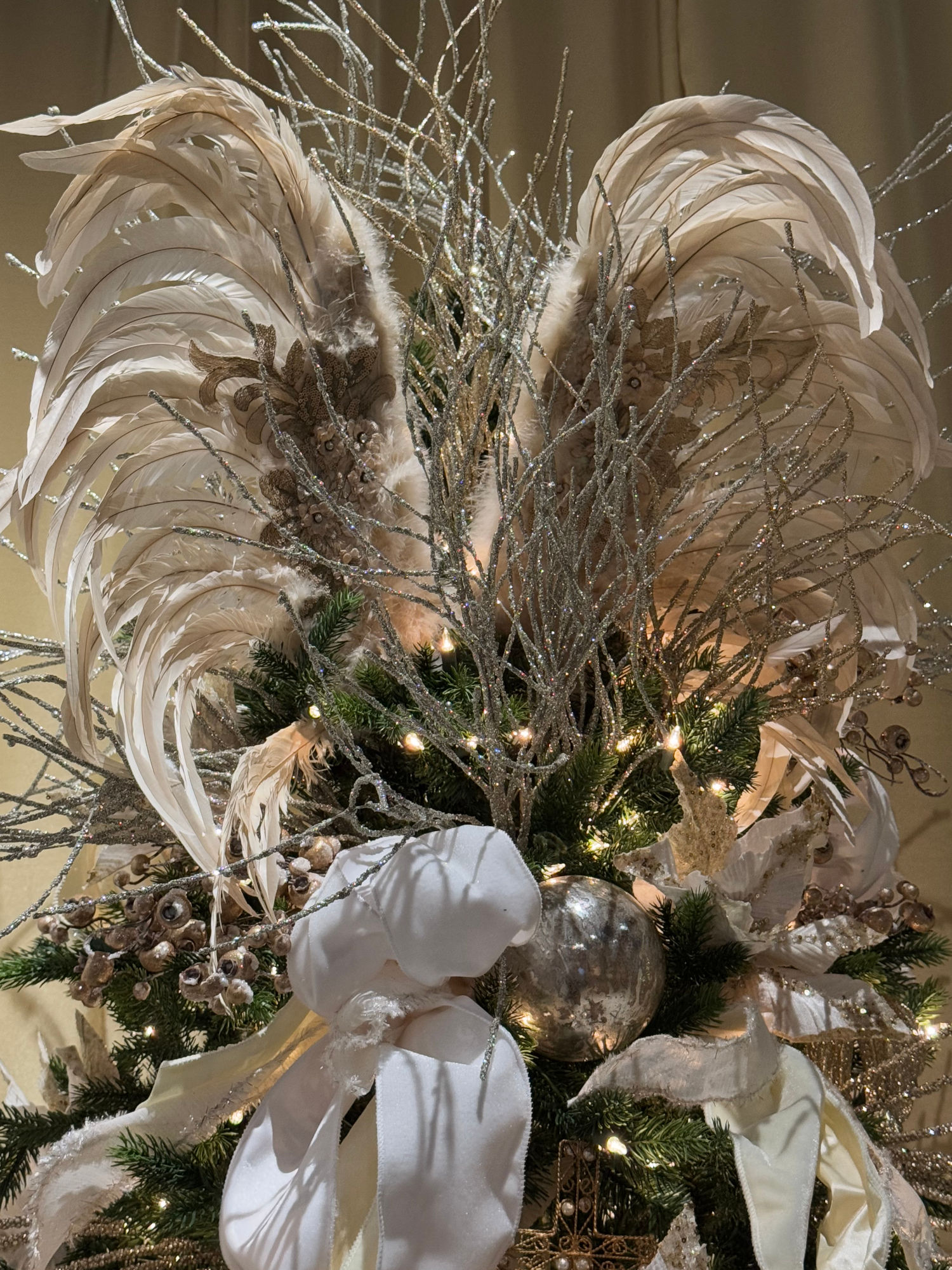


Vatican Christmas Tree Inauguration
The tradition of placing a giant Christmas tree in St. Peter's Square dates back to 1982 during the pontificate of Pope John Paul II. This year, the tree will be a 28-metre red fir donated by the archdiocese of Elk, northeastern Poland. The switching on ceremony will take place at 4.30pm on December 7 and alongside the tree will stand a larger than life-size nativity scene crafted by artisans from the nearby Campania region.Christmas Eve Mass
Tickets for Christmas Eve Mass in St. Peter's Basilica are free but incredibly difficult to obtain. As the Vatican recommends applying for tickets no less than two months in advance, the easier option is just to show up at St. Peter's Square and join the crowds watching the ceremony on the big screens.Urbi et Orbi
On Christmas Day the Pope gives a special blessing to the crowd at St. Peter's Square from the loggia balcony of St. Peter's Basilica. The Urbi et Orbi blessing takes place just twice a year, at Christmas and Easter, and is addressed to the citizens of Rome (urbi) and of the world (orbi). It's free to just turn up but prepare for a massive crowd.




WIKIPEDIAAKA The Saint Peter's Square Christmas Tree
The decorated tree that is erected annually in the Saint Peter's Square directly in front of St. Peter's Basilica in the Vatican City to celebrate the Christmas holiday season.The tradition of placing a Christmas tree as well as the life-size Nativity scene in Saint Peter's Square started in 1982 during the pontificate of Pope John Paul II, when the Polish-born Pope introduced the northern European symbol of Christmas spirit. The tradition of erecting a Christmas Tree was celebrated in northern Europe and in Poland, Pope John Paul II's country of origin, but not in the Vatican at the time.
The first tree came from Italy. Since then, the offering of the Christmas Tree to the Pope has become an honor, and each year the Vatican accepts a tree donated by a different European country or region.
The Christmas tree is installed in the center of Saint Peter's Square, together with a life-size nativity scene that is unveiled on Christmas Eve. The nativity scene has seventeen life-size statues. Of these, nine are the original figures donated in 1842 by Saint Vincent Pallotti for the nativity scene in the Roman church of Sant'Andrea della Valle, and the other eight figures were added over the course of the years. In 2006 the Italian province of Trentino, and the local council of a village of Tesero, have provided a further thirteen sculpted wooden figures and animals, as well as household utensils for the depiction of daily life.


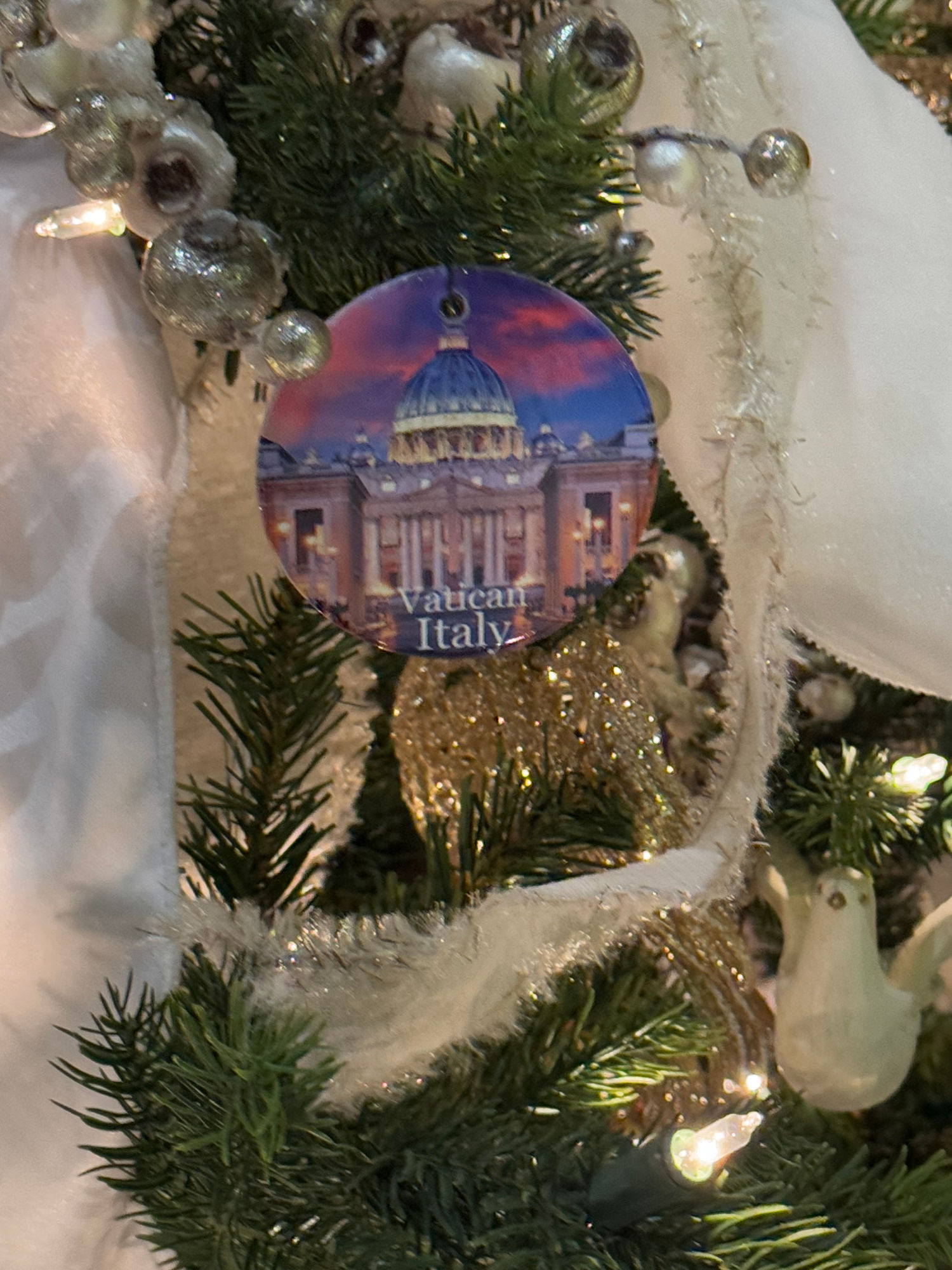
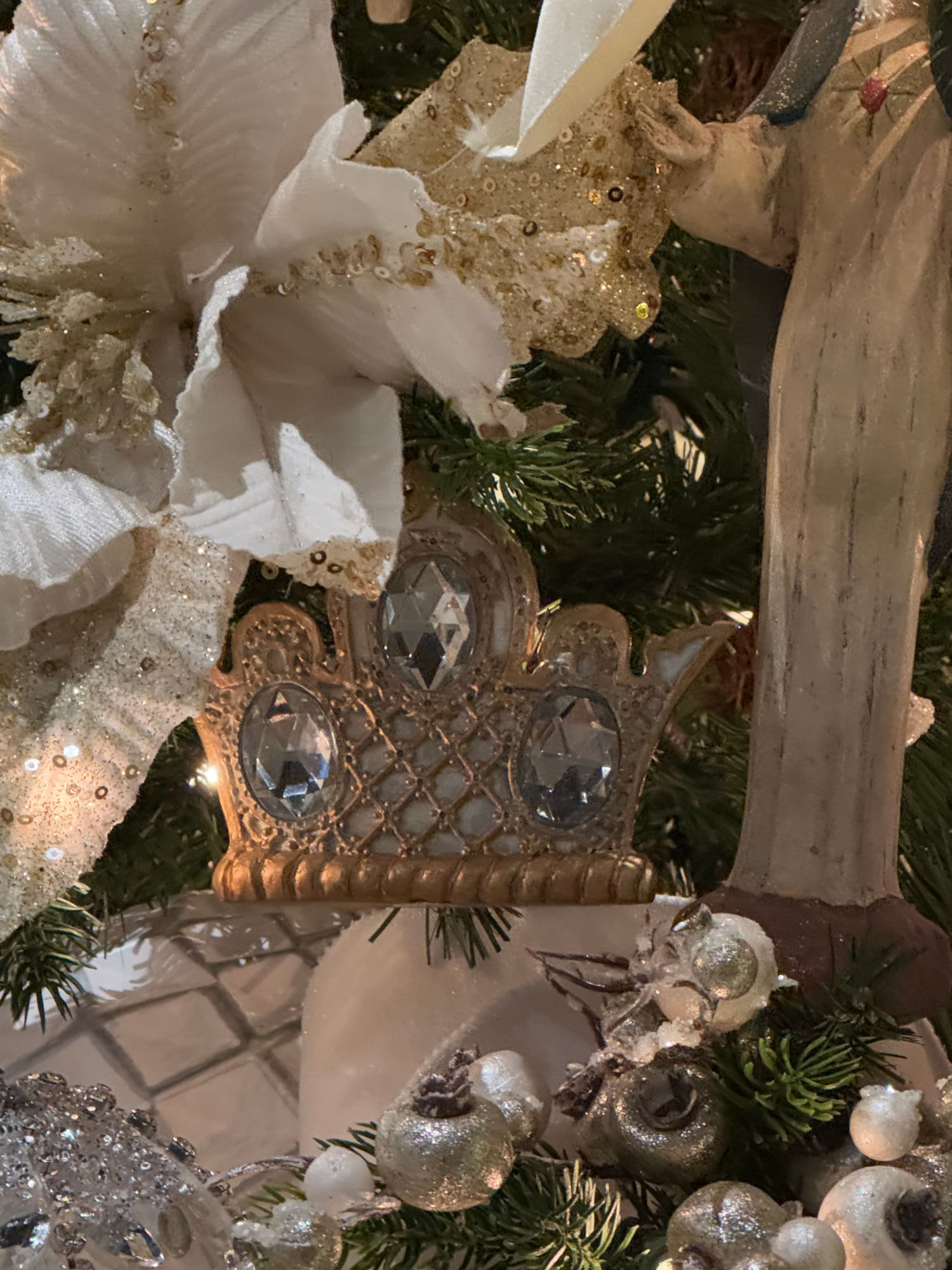
Reddit r/travel2017
Hey all! We recently had a great vacation in Italy, and attended Midnight Mass on Christmas Eve in Saint Peters Basilica in the Vatican. However, the process was pretty confusing so I wanted to document it for future travelers. This is relevant to the 2017 Christmas Eve mass, so hopefully it doesn't change so much in the future.To get tickets, first you need to get a letter from the Pope. You fax the Vatican with a request. We received our letter that ALLOWS you to pick up tickets after a month or so if you get accepted. We requested in ~May and were accepted for two people.
Next, once you're in Rome, you have to pick up the tickets from the Swiss Guard with your letter, so don't forget that letter. You pick them up BEFORE Christmas Eve, 1-3 days beforehand, so you'll need to swing by the Swiss Guard at the Vatican. This was confusing, so here's some details. Once I figured out what to do, the process could've taken 10 minutes or so at the time I went - no lines to wait in.
- The main goal here is to hand your Pope Letter to the Swiss Guard, and they'll hand you back your tickets. That's marked as "Turn in letter" on my awesome map. So enter St. Peter's Square like any other tourist.
- However, you can't just stroll up to the Swiss Guard by jumping barriers, which is the confusing part. They're behind the security checkpoint, the same security check that is handling the long line for people wanting to get into the church. However, we were able to skip that and NOT wait in line by going right up to the cops at the security point (not by being rude and barging through the line, but by going up to the checkpoint sideways where there are barriers and you can talk to a cop). I marked this "Security check" on the map. They allowed ONE person (the person the letter is addressing) to bypass security and walk up to the Swiss Guard.
- Once you're at the Bronze Door that the Swiss Guard are guarding (can't miss 'em, they have halbreds and pikes and are dressed like Renaissance-era Auburn or Florida fans), walk up the stairs and say something like "I have this Pope Letter for Midnight Mass and I'd like to pick up my tickets." Don't sweat this, they were super-nice. One of them disappeared for a minute and handed me back an envelope with my name on it with my two tickets.
- Exit back out the way you came without causing any sort of international incident just because you bypassed security.
So now you have your tickets. The next confusing part was attending.

- Midnight Mass isn't at midnight. In 2017, the time on the tickets said 9:30 PM.
- Remember: those tickets do not guarantee getting into the church, just that you can if they have room. They "overbook." So you'll want to get into line early.
- On my map, see that dark black line? That's where the line for security formed. We entered the line at the north end of my dark black line, and that was at 6:00 PM - yep, 3.5 hours beforehand. Bring a snack. There are restaurants on the street that you can duck into to pee if you buy something (I bought a couple of water bottles and they were fine with me using the restroom).
- They don't let people into the square until 8:15 or so, so that line won't move for awhile.
- In 2017 (again, things might change) this is the line for people without AND with Basilica tickets. We spent way too much energy trying to figure out if this was the "line for the church" or just "the line for the square" but they were the same. It's just the security line for everyone.
- We freaked out at one point because they started routing us to other security checkpoints around the square - just go with the flow.
- Once we got into the square after security, there was another line for people with church tickets that formed towards the same security checkpoint I mentioned earlier. Try to spot this other line forming and go stand in there, checking with people that they're the same level of confused about it as you are.
After that line, we were in the Basilica! I hope this helps out future travelers that were as confused as we were on what was going on.




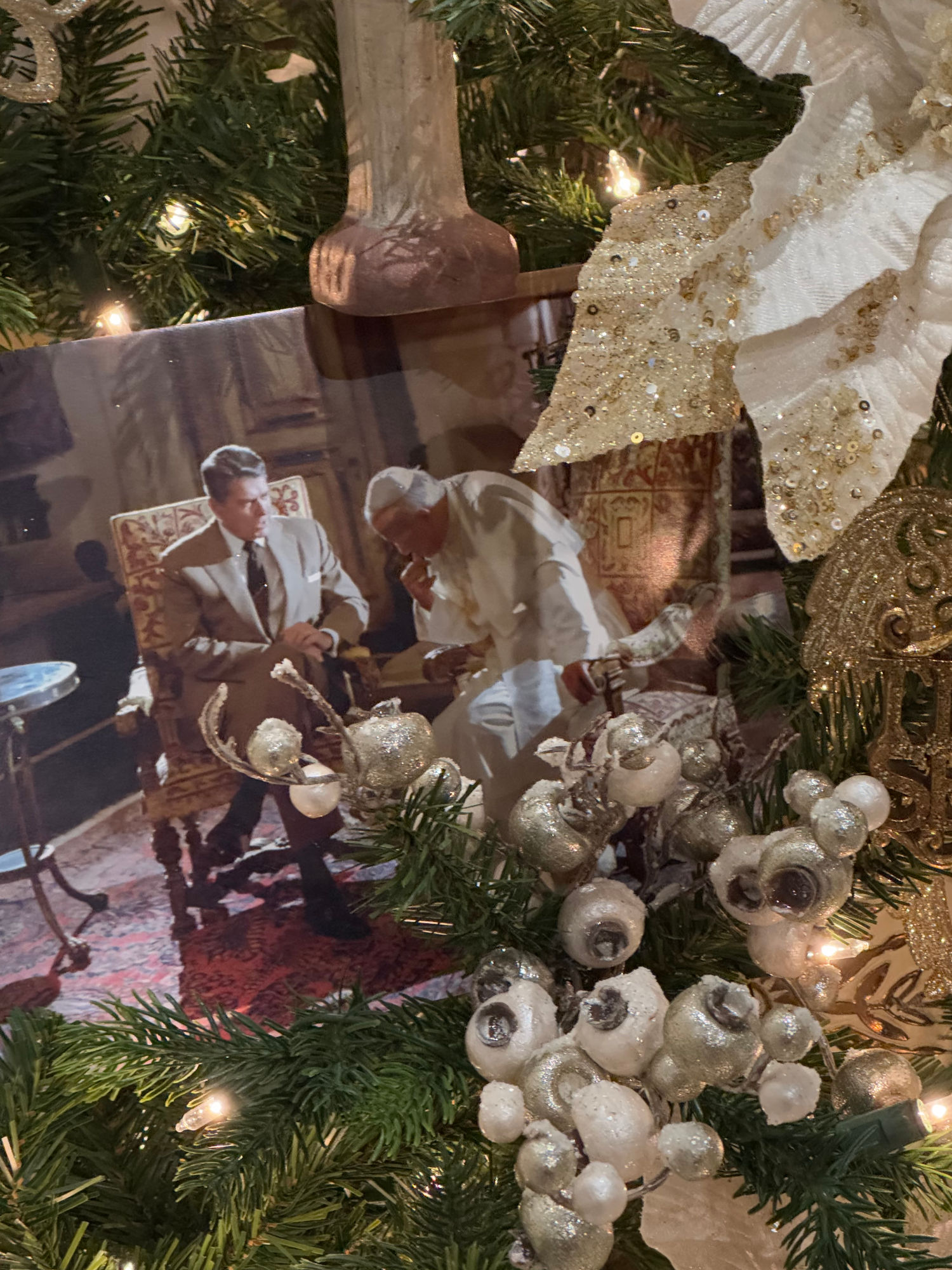
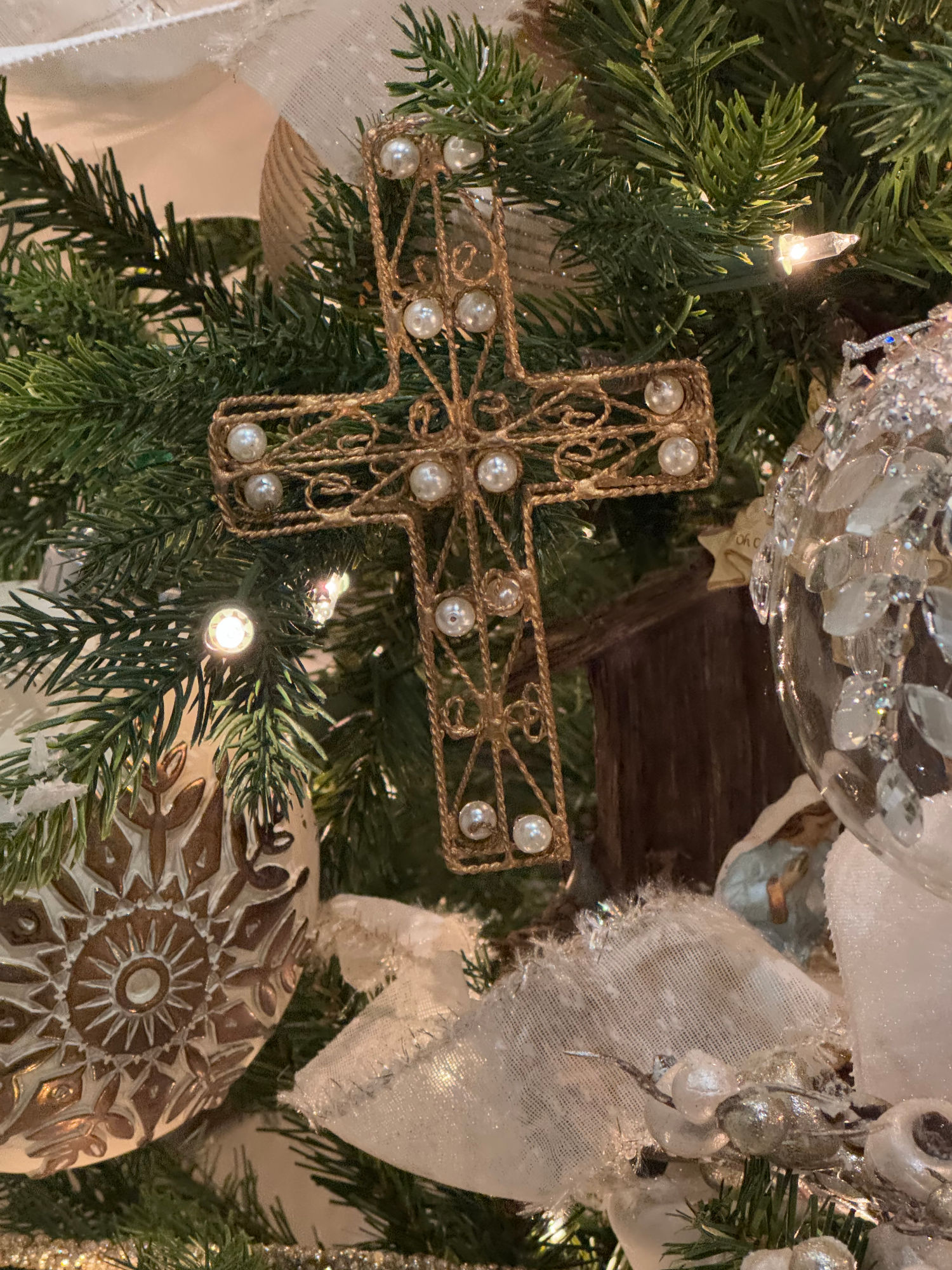


President Reagan Nancy Reagan Pope John Paul II at the Papal Library Vatican Pontifical Palace in Italy.
Reagan's Daily DiaryMonday, June 7, 1982
We flew out Wed. morning-I was loaded with briefing books until my head was stuffed with more than I needed to know. Flying into night we arrived in Paris at near midnight their time but only 6 P.M. ours. Met by Van & Bootsie Galbraith our Ambassador plus a welcoming French group. Put up at the Ambassadors residence which is a magnificent palace built in 1840. Suddenly the W.H. looked like an ordinary residence. I had meetings the next day with P.M. Susuzki & Thatcher-plus briefings and that night-Thurs a black tie dinner for Pres. Mitterrand. Fri. visited Mayor Chirac. Every place we drove the streets were lined with friendly crowds. Left Nancy in Paris and flew to Versailles for 1st dinner with the Summit group. Sat. the plenary sessions began. There were differences over East-West trade, Global negotiations and credits to Soviet U. plus how to stabilize currency exchange rates. We more than held our own and I believe came out on top. Sundays meetings were topped with a dinner in the Hall of Mirrors-the table had to be at least 100 feet long-an unbelievably beautiful sight. Nancy had joined me. Then we were entertained by the Paris Opera & later a recital in the Palace Chapel. Up early Mon. morning and off to Rome for meeting with Pope. A group of young American priests broke into song-"America the Beautiful." Both of us were crying. Lunched with Pres. Pertini-then called on P.M. Spadolini. Met the young men (police) who had saved Gen. Dozier. Again, the streets were lined with cheering people. We were told that had never been done for any other head of state. Flew out for London & helicoptered to Windsor Castle. This was a fairy tale experience. Black tie dinner with the Queen & Prince Phillip plus family-the Queen Mother et al. The next day a ride with the Queen. Nancy & the Prince did a carriage of 4 (horses.) We then left for London-I addressed Joint session of Parliament. First Pres. ever to do so. Lunch with P.M. Thatcher then back to Windsor for a White tie dinner-almost as spectacular as Versailles-1 long table for about 150 guests. Bonn and Berlin were again a series of palaces. The N.A.T.O. meeting was a success in every way. We were housed in an old castle complete with moat. Thurs. night a dinner hosted by Pres. & Mrs. Carstens of Germany-they are very nice. Fri. to Berlin-Checkpoint Charley and a heartwarming welcome by hundreds of our mil. personnel & their familys. Final event a speech in Charlottenberg Castle gardens to 25,000 Germans waving American flags. Almost forgot-1st day in Bonn addressed the Bundastag (Parliament). It was hailed as a great success. While in Bonn learned the House had passed a budget-we’re on our way. Also learned though that Israel had invaded Lebanon. I’m afraid we are faced with a real crisis.Key Facts
- President Reagan meets with Pope John Paul II at the Vatican.
- President Reagan travels to Windsor Castle and meets with Queen Elizabeth, Prince Phillip and the Queen Mother.
- In Chad, the rebel forces of former Prime Minister Hissene Habre capture the capital of Ndjamena and overthrow the government of President Goukouni Oueddei.
RONALD REAGANRemarks Following a Meeting With Pope John Paul II in Vatican CityJune 7, 1982
The President. Your Holiness, your Eminences, your Excellencies, members of the clergy, and ladies and gentlemen:
On behalf of myself and for all Americans, I want to express profound appreciation to you, Your Holiness, and to all of those from the Holy City who made it possible for us to meet in Vatican City.
This is truly a city of peace, love, and charity, where the highest to the humblest among us seek to follow in the footsteps of the fishermen. As you know, Your Holiness, this is my first visit to Europe as President. And I would like to think of it as a pilgrimage for peace, a journey aimed at strengthening the forces for peace in the free West by offering new opportunities for realistic negotiations with those who may not share the values of freedom and the spirit we cherish.
This is no easy task, but I leave this audience with a renewed sense of hope and dedication. Hope -- because one cannot meet a man like Your Holiness without feeling that a world that can produce such courage and vision out of adversity and oppression is capable, with God's help, of building a better future. Dedication -- because one cannot enter this citadel of faith, the fountainhead of so many of the values we in the free West hold dear, without coming away resolved to do all in one's power to live up to them.
Certain common experiences we've shared in our different walks of life, Your Holiness, and the warm correspondence we've carried on, also, gave our meeting a special meaning for me. I hope that others will follow. Let me add that all Americans remember with great warmth your historic visit to our shores in 1979. We all hope that you'll be back again with your timeless message. Ours is a nation grounded on faith, faith in man's ability through God-given freedom to live in tolerance and peace and faith that a Supreme Being guides our daily striving in this world. Our national motto, "In God We Trust," reflects that faith.
Many of our earliest settlers came to America seeking a refuge where they could worship God unhindered, so our dedication to individual freedom is wedded to religious freedom as well. Liberty has never meant license to Americans. We treasure it precisely because it protects the human and spiritual values that we hold most dear: the right to worship as we choose, the right to elect democratic leaders, the right to choose the type of education we want for our children, and freedom from fear, want, and oppression. These are God-given freedoms, not the contrivances of man.
We also believe in helping one another through our churches and charitable institutions or simply as one friend, one good Samaritan to another. The Ten Commandments and the Golden Rule are as much a part of our living heritage as the Constitution we take such pride in. And we have tried -- not always successfully, but always in good conscience -- to extend those same principles to our role in the world.
We know that God has blessed America with the freedom and abundance many of our less fortunate brothers and sisters around the world have been denied. Since the end of World War II, we have done our best to provide assistance to them, assistance amounting to billions of dollars worth of food, medicine, and materials. And we'll continue to do so in the years ahead. Americans have always believed that in the words of the Scripture, "Unto whomsoever much is given, of him shall be much required."
To us, in a troubled world, the Holy See and your pastorate represent one of the world's greatest moral and spiritual forces. We admire your active efforts to foster peace and promote justice, freedom, and compassion in a world that is still stalked by the forces of evil. As a people and as a government, we seek to pursue the same goals of peace, freedom, and humanity along political and economic lines that the Church pursues in its spiritual role. So, we deeply value your counsel and support and express our solidarity with you.
Your Holiness, one of the areas of our mutual concern is Latin America. We want to work closely with the Church in that area to help promote peace, social justice, and reform, and to prevent the spread of repression and godless tyranny. We also share your concern in seeking peace and justice in troubled areas of the Middle East, such as Lebanon.
Another special area of mutual concern is the martyred nation of Poland -- your own homeland. Through centuries of adversity, Poland has been a brave bastion of faith and freedom in the hearts of her courageous people, if not in those who rule her.
We seek a process of reconciliation and reform that will lead to a new dawn of hope for the people of Poland, and we'll continue to call for an end to martial law, for the freeing of all political prisoners, and to resume dialog among the Polish Government, the Church, and the Solidarity movement which speaks for the vast majority of Poles. While denying financial assistance to the oppressive Polish regime, America will continue to provide the Polish people with as much food and commodity support as possible through church and private organizations.
Today, Your Holiness, marks the beginning of the United Nations Special Session on Disarmament. We pledge to do everything possible in these discussions, as in our individual initiatives for peace and arms reduction, to help bring a real, lasting peace throughout the world. To us, this is nothing less than a sacred trust.
Dante has written that, "The infinite goodness has such wide arms that it takes whatever turns to it." We ask your prayers, Holy Father, that God will guide us in our efforts for peace on this journey and in the years ahead and that the wide arms of faith and forgiveness can some day embrace a world at peace, with justice and compassion for all mankind.
The Pope. Mr. President, I am particularly pleased to welcome you today to the Vatican. Although we have already had many contacts, it is the first time that we have met personally.
In you, the President of the United States of America, I greet all the people of your great land. I still remember vividly the warm welcome that I was given by millions of your fellow citizens less than 3 years ago. On that occasion, I was once more able to witness firsthand the vitality of your nation. I was able to see again how the moral and spiritual values transmitted by your Founding Fathers find their dynamic expression in the life of modern America.
The American people are indeed proud of their right to life, liberty, and the pursuit of happiness. They are proud of civil and social progress in American society as well as their extraordinary advances in science and technology.
As I speak to you today, it is my hope that the entire structure of American life will rest ever more securely on the strong foundation of moral and spiritual values. Without the fostering and defense of these values, all human advancement is stunted and the very dignity of the human person is endangered.
Throughout the course of their history, and especially in difficult times, the American people have repeatedly risen to challenges presented to them. They have given many proofs of unselfishness, generosity, concern for others, concern for the poor, the needy, the oppressed. They have shown confidence in that great ideal of being a united people with a mission of service to perform.
At this present moment in the history of the world, the United States is called, above all, to fulfill its mission in the service of world peace. The very condition of the world today calls for a far-sighted policy that will favor those indispensable conditions of justice and freedom, of truth and love, that are the foundations of lasting peace.
Mr. President, my own greatest preoccupation is for the peace of the world, peace in our day.
In many parts of the world, there are centers of acute tension. This acute tension is manifested above all in the crisis of the South Atlantic, in the war between Iran and Iraq, and, now, in the grave crisis provoked by the new events in Lebanon. This grave crisis in Lebanon likewise merits the attention of the world because of the danger it contains of further provocation in the Middle East, with immense consequences for world peace.
There are, fortunately, many factors in society that today positively contribute to peace. These positive factors include an increasing realization of the interdependence of all peoples, the growing solidarity with those in need, and a greater conviction of the absurdity of war as a means of resolving controversies between nations.
During my recent visit to Britain, I stated in particular that the scale and the horror of modern warfare, whether nuclear or not, makes it totally unacceptable as a means of settling differences between nations. And for those who profess the Christian faith, I offer it as motivation the fact that when you are in contact with the Prince of Peace, you understand how totally opposed to His message are hatred and war.
The duty of peace falls especially upon the leaders of the world. It is up to the representatives of governments and peoples to work to free humanity not only from wars and conflicts but from the fear that is generated by ever more sophisticated and deadly weapons.
Peace is not only the absence of war; it also involves reciprocal trust between nations, a trust that is manifested and proved through constructive negotiations that aim at ending the arms race and at liberating immense resources that can be used to alleviate misery and feed millions of hungry human beings.
All effective peacemaking requires foresightedness, for foresightedness is a quality needed in all peacemakers. You, your own great nation is called to exercise this foresightedness as are all the nations of the world. This quality enables leaders to commit themselves to those concrete programs which are essential to world peace -- programs of justice and development, efforts to defend and protect human life, as well as initiatives that favor human rights. On the contrary, anything that wounds, weakens, or dishonors human dignity in any aspect imperils the cause of the human person and at the same time the peace of the world.
The relations between nations are greatly affected by the development issue which preserves its full relevance in this day of ours. Success in resolving questions in the North-South dialog will continue to be the gates of peaceful relations between values, political communities, and continue to influence the peace of the world in the years ahead.
Economic and social advancement linked to financial collaboration between peoples remains an apt goal for the renewed efforts of the statesmen of the world.
A truly universal concept of the common good of the human family is an incomparable instrument in building the edifice of the world today. It is my own conviction that a united and concerned America can contribute immensely to the cause of world peace through the efforts of her leaders and the commitment of all her citizens. Dedicated to the high ideals of her traditions, America is in a splendid position to help all humanity enjoy what she herself is intent on possessing.
With faith in God and belief in universal human solidarity may America step forward in this crucial moment in history to consolidate her rightful place at the service of world peace. In this sense, Mr. President, I repeat today those words that I spoke when I left the United States in 1979. My final prayer is this: that God will bless America so that she may increasingly become and truly be and long remain one nation under God, indivisible, with liberty and justice for all.
Thank you very much.
NOTEThe President spoke at 12:41 p.m. in the Papal Library at the Vatican Palace following his private meeting with the Pope.
WIKIPEDIAThe Vatican City State
A a landlocked independent country, city-state, microstate, and enclave within Rome, Italy. It became independent from Italy in 1929 with the Lateran Treaty, and it is a distinct territory under "full ownership, exclusive dominion, and sovereign authority and jurisdiction" of the Holy See, itself a sovereign entity under international law, which maintains the city-state's temporal power and governance, diplomatic, and spiritual independence.With an area of 121 acres and as of 2023 a population of about 764, it is the smallest state in the world both by area and by population.
- As governed by the Holy See, Vatican City State is an ecclesiastical or sacerdotal-monarchical state ruled by the Pope, who is the bishop of Rome and head of the Catholic Church.
- The highest state functionaries are all Catholic clergy of various origins.
- After the Avignon Papacy (1309–1377) the popes have mainly resided at the Apostolic Palace within what is now Vatican City, although at times residing instead in the Quirinal Palace in Rome or elsewhere. The Vatican is also a metonym for the Holy See.
- The Holy See dates back to early Christianity and is the principal episcopal see of the Catholic Church, which has approximately 1.329 billion baptized Catholics in the world as of 2018 in the Latin Church and 23 Eastern Catholic Churches. The independent state of Vatican City, on the other hand, came into existence on 11 February 1929 by the Lateran Treaty between the Holy See and Italy, which spoke of it as a new creation, not as a vestige of the much larger Papal States (756–1870), which had previously encompassed much of Central Italy.
- As of 2023, Vatican City had a population of 764 residents, regardless of citizenship. There were also 372 Vatican citizens residing elsewhere, consisting of diplomats of the Holy See to other countries and cardinals residing in Rome. The population is composed of clergy, other religious members, laypeople serving the state (such as the Swiss Guard) and their family members. In 2013 there were 13 families of the employees of the Holy See living in Vatican City, in 2019 there were 20 children of the Swiss Guards living at the Vatican.
- The Holy See which most often uses Latin for the authoritative version of its official documents, Vatican City uses only Italian in its legislation and official communications. Italian is also the everyday language used by most of those who work in the state. In the Swiss Guard, Swiss German is the language used for giving commands, but the individual guards take their oath of loyalty in their own languages: German, French, Italian or Romansh.
- Unlike citizenship of other states, which is based either on jus sanguinis (birth from a citizen, even outside the state's territory) or on jus soli (birth within the territory of the state), citizenship of Vatican City is granted on jus officii, namely on the grounds of appointment to work in a certain capacity in the service of the Holy See. It usually ceases upon cessation of the appointment. Citizenship is also extended to the spouse and children of a citizen, provided they are living together in the city.
- Vatican City is home to some of the most famous art in the world. St. Peter's Basilica, whose successive architects include Bramante, Michelangelo, Giacomo della Porta, Maderno and Bernini, is a renowned work of Renaissance architecture. The Sistine Chapel is famous for its frescos, which include works by Perugino, Domenico Ghirlandaio and Botticelli as well as the ceiling and Last Judgment by Michelangelo.
Vatican City contains religious and cultural sites such as St. Peter's Basilica, the Sistine Chapel, the Vatican Apostolic Library, and the Vatican Museums. They feature some of the world's most famous paintings and sculptures. The unique economy of Vatican City is supported financially by donations from the faithful, by the sale of postage stamps and souvenirs, fees for admission to museums, and sales of publications. Vatican City has no taxes and items are duty-free.
EtymologyThe name Vatican City was first used in the Lateran Treaty, signed on 11 February 1929, which established the modern city-state named after Vatican Hill, the geographic location of the state within the city of Rome. "Vatican" is derived from the name of an Etruscan settlement, Vatica or Vaticum, located in the general area the Romans called Ager Vaticanus, "Vatican territory".The Italian name of the city is Città del Vaticano or, more formally, Stato della Città del Vaticano, meaning 'Vatican City State'. Its Latin name is Status Civitatis Vaticanae; this is used in official documents by the Holy See, the Church and the Pope.














